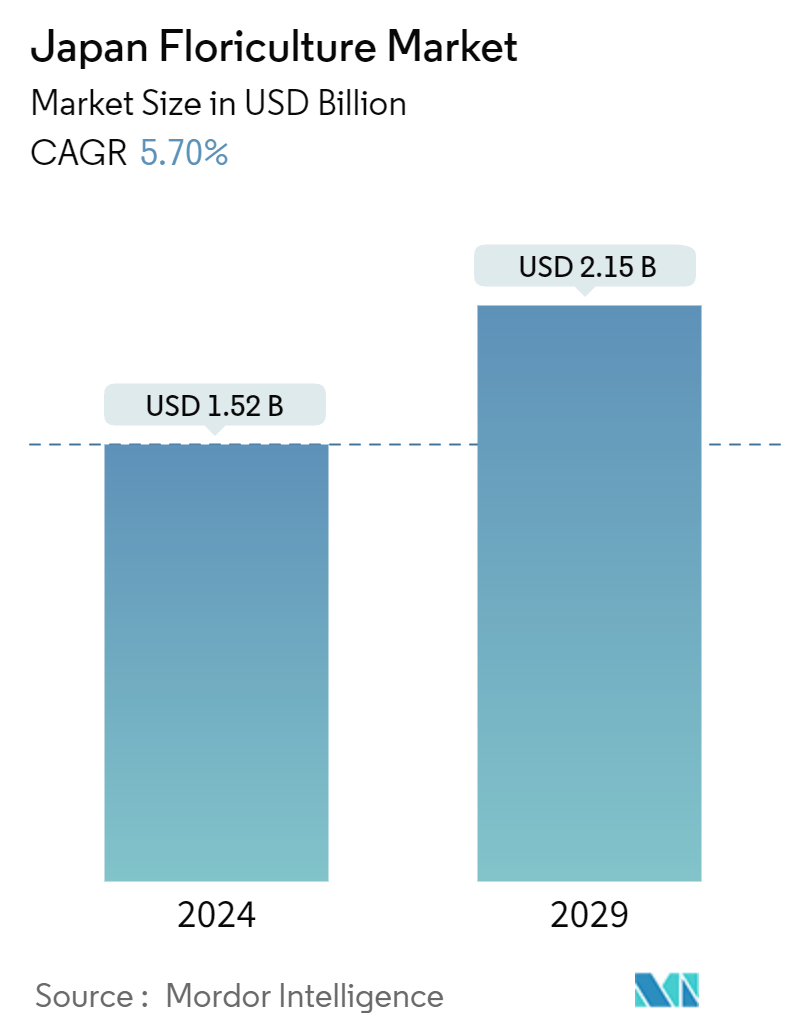Market Size of Japan Floriculture Industry

| Study Period | 2019 - 2029 |
| Base Year For Estimation | 2023 |
| Forecast Data Period | 2024 - 2029 |
| Market Size (2024) | USD 1.52 Billion |
| Market Size (2029) | USD 2.15 Billion |
| CAGR (2024 - 2029) | 5.70 % |
Japan Floriculture Market Analysis
The Japan Floriculture Market size is estimated at USD 1.52 billion in 2024, and is expected to reach USD 2.15 billion by 2029, growing at a CAGR of 5.70% during the forecast period (2024-2029).
- The Japanese floriculture market is vibrant and dynamic, renowned for its high-quality flowers, innovative arrangements, and cultural significance. It is characterized by a diverse range of players, including domestic producers, importers, wholesalers, and retailers. Popular flowers in Japan include chrysanthemums, lilies, roses (bara), orchids, and carnations, often used in traditional arrangements and ikebana. In July 2024, the country saw the rare bloom of the "Century Plant" for the first time in a century. Events like these drive the market's expansion.
- Flowers hold significant cultural importance in Japan, symbolizing beauty, purity, and respect. For example, the cherry blossom, or sakura, serves as Japan's emblem. It embodies beauty, sweetness, and gentleness, with its fleeting lifespan symbolizing the transient essence of beauty. Cherry blossoms are used in various ceremonies, festivals, and everyday life. The market has witnessed notable trends, such as the growing popularity of imported flowers, the emergence of young online florists, and the increased demand for sustainable and locally grown flowers. According to the ITC Trade Map, in 2023, Japan imported 23,194 metric tons of cut chrysanthemum flowers, 7.1% more than the previous year.
- Despite facing challenges like rising costs and competition from imported flowers, the Japanese floriculture market continues to evolve and adapt. Innovations in cultivation techniques, packaging, and marketing have helped to sustain its growth. Additionally, the market's focus on quality, craftsmanship, and cultural significance has contributed to its enduring appeal.
Japan Floriculture Industry Segmentation
Floriculture is a horticulture practice focusing on the cultivation of flowering and ornamental plants for garden and commercial use.
The Japanese floriculture market is segmented by type of flowers (cut flowers, bulbous plants, and potted flowers). The report includes value chain analysis and trade analysis (import by value and volume and export analysis by value and volume). The report offers market sizes and forecasts in terms of value (USD) and volume (metric tons) for all the above segments.
| Type of Flowers | ||||||||
| ||||||||
| Bulbous Plants | ||||||||
| Potted Flowers |
Japan Floriculture Market Size Summary
The Japanese floriculture market is a significant player on the global stage, ranking among the top ten largest floriculture industries worldwide. The market is characterized by a stable demand for flowers, with supermarkets and shops serving as traditional retail outlets. The wholesale sector dominates the market, supplying the majority of flowers, and is recognized as one of the largest wholesale flower markets globally. Flowers in Japan are purchased for various purposes, including personal use, professional settings, and decorative purposes in hotels, with heightened demand during national events and holidays. The market benefits from a well-established import system, primarily sourcing cut flowers from Asian countries, which cater to the consumer preference for new flower varieties. This robust import and wholesale trade, coupled with the availability of high-quality products at competitive prices, is expected to drive market growth in the coming years.
The floriculture industry in Japan is also witnessing a shift in demographics, with an increasing number of young farmers engaging in flower production. This trend is contributing to the market's expansion, as young growers adopt energy-saving production technologies and cultivate a variety of flowers for both domestic and export markets. Cut flowers dominate the cultivated area, with chrysanthemums being the most popular, followed by carnations and roses. The strong export values and quality of Japanese floriculture products support the industry's robustness. Despite the reliance on imports to meet domestic demand, the market continues to thrive, supported by initiatives such as international collaborations and technological advancements in agriculture. These factors collectively contribute to the dynamic growth and development of the Japanese floriculture market.
Japan Floriculture Market Size - Table of Contents
-
1. MARKET DYNAMICS
-
1.1 Market Overview
-
1.2 Market Drivers
-
1.2.1 Rising Development of New Varieties of Flowers
-
1.2.2 Growing Popularity of Imported Flowers
-
1.2.3 Demographic Shift in Farmers Engaged in Floriculture
-
-
1.3 Market Restraints
-
1.3.1 Rising Cost of Production
-
1.3.2 Competition From Imported Flowers
-
-
-
2. MARKET SEGMENTATION
-
2.1 Type of Flowers
-
2.1.1 Cut Flowers
-
2.1.1.1 Carnation
-
2.1.1.2 Rose
-
2.1.1.3 Chrysanthemum
-
2.1.1.4 Lily
-
2.1.1.5 Orchid
-
2.1.1.6 Other Types of Flowers
-
-
2.1.2 Bulbous Plants
-
2.1.3 Potted Flowers
-
-
Japan Floriculture Market Size FAQs
How big is the Japan Floriculture Market?
The Japan Floriculture Market size is expected to reach USD 1.52 billion in 2024 and grow at a CAGR of 5.70% to reach USD 2.15 billion by 2029.
What is the current Japan Floriculture Market size?
In 2024, the Japan Floriculture Market size is expected to reach USD 1.52 billion.

